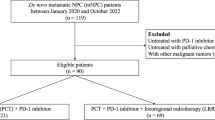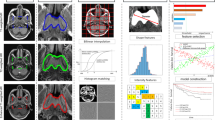Abstract
Radioresistance poses a major challenge in nasopharyngeal carcinoma (NPC) treatment. Clinical tumor-node-metastasis (TNM) staging has limited accuracy in predicting NPC radioresponse and determining its therapeutic regimens. To construct a risk score model for predicting NPC radioresistance, immunohistochemistry was used to assess the expression of four proteins (14-3-3σ, Maspin, RKIP, and GRP78) in 149 NPC samples with different radiosensitivity. Sequentially, a logistic regression analysis was performed to identify independent predictors of NPC radioresistance and establish a risk score model. As a result, a risk score model, Z = −3.189 − 1.478 (14-3-3σ) − 1.082 (Maspin) − 1.666 (RKIP) + 2.499 (GRP78) + 2.597 (TNM stage), was constructed, and a patient’s risk score was estimated by the formula: e Z/(e Z + 1) × 100, where “e” is the base of natural logarithm. High-risk score was closely associated with NPC radioresistance, and was observed more frequently in the radioresistant patients than that in the radiosensitive patients. The sensitivity, specificity, and accuracy of the risk score model for predicting NPC radioresistance was 88.00, 86.48, and 87.25 %, respectively, which was clearly superior to each individual protein and TNM stage. Furthermore, Kaplan-Meier survival analysis showed that high-risk score correlated with the markedly reduced overall survival (OS) and disease-free survival (DFS) of the patients, and Cox regression analysis showed that the risk score model was an independent predictor for OS and DFS. This study constructs a risk score model for predicting NPC radioresistance and patient survival, and it may serve as a complement to current radioresistance risk stratification approaches.



Similar content being viewed by others
References
Chang ET, Adami HO. The enigmatic epidemiology of nasopharyngeal carcinoma. Cancer Epidemiol Biomarkers Prev. 2006;15:1765–77.
Wei WI, Sham JS. Nasopharyngeal carcinoma. Lancet. 2005;365:2041–54.
Lee AW, Poon YF, Foo W, Law SC, Cheung FK, Chan DK, et al. Retrospective analysis of 5037 patients with nasopharyngeal carcinoma treated during 1976–1985: overall survival and patterns of failure. Int J Radiat Oncol Biol Phys. 1992;23:261–70.
Yamashita S, Kondo M, Hashimoto S. Squamous cell carcinoma of the nasopharynx. an analysis of failure patterns after radiation therapy. Acta Radiol Oncol. 1985;24:315–20.
Jin H, Xie X, Wang H, Hu J, Liu F, Liu Z, et al. ERCC1 Cys8092Ala and XRCC1 Arg399Gln polymorphisms predict progression-free survival after curative radiotherapy for nasopharyngeal carcinoma. PLoS One. 2014;9:e101256.
Zhou GQ, Tang LL, Mao YP, Chen L, Li WF, Sun Y, et al. Baseline serum lactate dehydrogenase levels for patients treated with intensity-modulated radiotherapy for nasopharyngeal carcinoma: a predictor of poor prognosis and subsequent liver metastasis. Int J Radiat Oncol Biol Phys. 2012;82:e359–65.
Hui EP, Sung FL, Yu BK, Wong CS, Ma BB, Lin X, et al. Plasma osteopontin, hypoxia, and response to radiotherapy in nasopharyngeal cancer. Clin Cancer Res. 2008;14:7080–7.
Le QT, Jones CD, Yau TK, Shirazi HA, Wong PH, Thomas EN, et al. A comparison study of different PCR assays in measuring circulating plasma epstein-barr virus DNA levels in patients with nasopharyngeal carcinoma. Clin Cancer Res. 2005;11:5700–7.
Huang CF, Cho CL, Huang CC, Wang JS, Shih YL, Su CY, et al. Loss of cyclin D1 and p16 expression correlates with local recurrence in nasopharyngeal carcinoma following radiotherapy. Ann Oncol. 2002;13:1246–51.
Valerie K, Yacoub A, Hagan MP, Curiel DT, Fisher PB, Grant S, et al. Radiation-induced cell signaling: inside-out and outside-in. Mol Cancer Ther. 2007;6:789–801.
Chen YP, Zhao BC, Chen C, Shen LJ, Gao J, Mai ZY, et al. Pretreatment platelet count improves the prognostic performance of the TNM staging system and aids in planning therapeutic regimens for nasopharyngeal carcinoma: a single-institutional study of 2, 626 patients. Chin J Cancer. 2015;34:137–46.
Talmi YP, Horowitz Z, Bedrin L, Wolf M, Chaushu G, Pfeffer MR. Quality of life of nasopharyngeal carcinoma patients. Cancer. 2002;94:1012–7.
Feng XP, Yi H, Li MY, Li XH, Yi B, Zhang PF, et al. Identification of biomarkers for predicting nasopharyngeal carcinoma response to radiotherapy by proteomics. Cancer Res. 2010;70:3450–62.
Chen Y, Ouyang GL, Yi H, Li MY, Zhang PF, Li C, et al. Identification of RKIP as an invasion suppressor protein in nasopharyngeal carcinoma by proteomic analysis. J Proteome Res. 2008;7:5254–62.
Laronga C, Yang HY, Neal C, Lee MH. Association of the cyclin-dependent kinases and 14-3-3σ negatively regulates cell cycle progression. J Biol Chem. 2000;275:23106–12.
Yang HY, Wen YY, Chen CH, Lozano G, Lee MH. 14-3-3σ positively regulates p53 and suppresses tumor growth. Mol Cell Biol. 2003;23:7096–107.
Zakharchenko O, Cojoc M, Dubrovska A, Souchelnytskyi S. A role of TGFß1 dependent 14-3-3σ phosphorylation at Ser69 and Ser74 in the regulation of gene transcription, stemness and radioresistance. PLoS One. 2013;8:e65163.
Sager R, Sheng S, Pemberton P, Hendrix MJ. Maspin: a tumor suppressing serpin. Adv Exp Med Biol. 1997;425:77–88.
Schaefer JS, Zhang M. Targeting maspin in endothelial cells to induce cell apoptosis. Expert Opin Ther Targets. 2006;10:401–8.
Mhawech-Fauceglia P, Dulguerov P, Beck A, Bonet M, Allal AS. Value of ezrin, maspin and nm23-1 protein expressions in predicting outcome of patients with head and neck squamous-cell carcinoma treated with radical radiotherapy. J Clin Pathol. 2007;60:185–9.
Lee AS. The glucose-regulated proteins: stress induction and clinical applications. Trends Biochem Sci. 2001;26:504–10.
Chiu CC, Lee LY, Li YC, Chen YJ, Lu YC, Li YL, et al. Grp78 as a therapeutic target for refractory head-neck cancer with CD24(-)CD44(+) stemness phenotype. Cancer Gene Ther. 2013;20:606–15.
Zhai L, Kita K, Wano C, Wu Y, Sugaya S, Suzuki N. Decreased cell survival and DNA repair capacity after UVC irradiation in association with down-regulation of GRP78/BiP in human RSa cells. Exp Cell Res. 2005;305:244–52.
Keller ET, Fu Z, Brennan M. The role of Raf kinase inhibitor protein (RKIP) in health and disease. Biochem Pharmacol. 2004;68:1049–53.
Fu Z, Smith PC, Zhang L, Rubin MA, Dunn RL, Yao Z, et al. Effects of raf kinase inhibitor protein expression on suppression of prostate cancer metastasis. J Natl Cancer Inst. 2003;95:878–89.
Woods Ignatoski KM, Grewal NK, Markwart SM, Vellaichamy A, Chinnaiyan AM, Yeung K, et al. Loss of Raf kinase inhibitory protein induces radioresistance in prostate cancer. Int J Radiat Oncol Biol Phys. 2008;72:153–60.
Ruan L, Wang GL, Yi H, Chen Y, Tang CE, Zhang PF, et al. Raf kinase inhibitor protein correlates with sensitivity of nasopharyngeal carcinoma to radiotherapy. J Cell Biochem. 2010;110:975–84.
Shanmugaratnam K, Sobin LH. The World Health Organization histological classification of tumours of the upper respiratory tract and ear. Cancer. 1993;71:12689–97.
Pan J, Xu Y, Qiu S, Zong J, Guo Q, Zhang Y, et al. A comparison between the Chinese 2008 and the 7th edition AJCC staging systems for nasopharyngeal carcinoma. Am J Clin Oncol. 2015;38:189–96.
Marrelli D, De Stefano A, de Manzoni G, Morgagni P, Di Leo A, Roviello F. Prediction of recurrence after radical surgery for gastric cancer: a scoring system obtained from a prospective multicenter study. Ann Surg. 2005;241:247–55.
Li W, Ye F, Wang D, Sun X, Tong W, Lian G, et al. Protein predictive signatures for lymph node metastasis of gastric cancer. Int J Cancer. 2013;132:1851–9.
Generali D, Symmans WF, Berruti A, Fox SB. Predictive immunohistochemical biomarkers in the context of neoadjuvant therapy for breast cancer. J Natl Cancer Inst Monogr. 2011;2011:99–102.
Chen X, Wu J, Lu H, Huang O, Shen K. Measuring β-tubulin III, Bcl-2, and ERCC1 improves pathological complete remission predictive accuracy in breast cancer. Cancer Sci. 2012;103:262–8.
Zimling ZG, Sørensen JB, Gerds TA, Bech C, Andersen CB, Santoni-Rugiu E. A biomarker profile for predicting efficacy of cisplatin-vinorelbine therapy in malignant pleural mesothelioma. Cancer Chemother Pharmacol. 2012;70:743–54.
Antonarakis ES, Keizman D, Zhang Z, Gurel B, Lotan TL, Hicks JL, et al. An immunohistochemical signature comprising PTEN, MYC and Ki67 predicts progression in prostate cancer patients receiving adjuvant docetaxel after prostatectomy. Cancer. 2012;118:6063–71.
Nagy VM, Buiga R, Brie I, Todor N, Tudoran O, Ordeanu C, et al. Expression of VEGF, VEGFR, EGFR, COX-2 and MVD in cervical carcinoma, in relation with the response to radio-chemotherapy. Rom J Morphol Embryol. 2011;52:53–9.
Acknowledgments
This work was supported by the Major Program of National Natural Science Foundation of China (81230053), National Key Technology R&D Program of China (2013BAI01B07), National Basic Research Program of China (2013CB910502), National Natural Science Foundation of China (81172559, 81172302), and Collaborative Innovation Center for Chemistry and Molecular Medicine of Hunan Province, China.
Conflicts of interest
None
Author information
Authors and Affiliations
Corresponding author
Rights and permissions
About this article
Cite this article
Yi, HM., Yi, H., Zhu, JF. et al. A five-variable signature predicts radioresistance and prognosis in nasopharyngeal carcinoma patients receiving radical radiotherapy. Tumor Biol. 37, 2941–2949 (2016). https://doi.org/10.1007/s13277-015-4139-y
Received:
Accepted:
Published:
Issue Date:
DOI: https://doi.org/10.1007/s13277-015-4139-y




